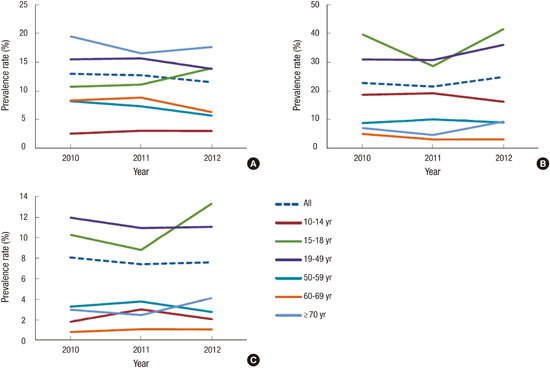1. Wu AC, Lesperance L, Bernstein H. Screening for iron deficiency. Pediatr Rev. 2002; 23:171–178.
2. Greydanus DE, Patel DR. The female athlete. Before and beyond puberty. Pediatr Clin North Am. 2002; 49:553–580.
3. de Benoist B, McLean E, Egli I, Cogswell M. Worldwide prevalence of anemia 1993-2005. WHO Global Database on Anemia 2008. p. 1–40. ISBN 978 92 4 159665 7(WH 155).
4. McLean E, Cogswell M, Egli I, Wojdyla D, de Benoist B. Worldwide prevalence of anaemia, WHO Vitamin and Mineral Nutrition Information System, 1993-2005. Public Health Nutr. 2009; 12:444–454.
6. Kim SK, Kang HS, Lee JE, Kwon YS, Jun YH, Kim CS, Kim YT. The prevalence change of anemia in the population aged 10 years or older: 2005 and 2009. Clin Pediatr Hematol Oncol. 2011; 18:8–12.
7. Kim SK, Kang HS, Kim CS, Kim YT. The prevalence of anemia and iron depletion in the population aged 10 years or older. Korean J Hematol. 2011; 46:196–199.
8. Lee JO, Lee JH, Ahn S, Kim JW, Chang H, Kim YJ, Lee KW, Kim JH, Bang SM, Lee JS. Prevalence and risk factors for iron deficiency anemia in the Korean population: results of the fifth Korea National Health and Nutrition Examination Survey. J Korean Med Sci. 2014; 29:224–229.
9. Chaves PH, Ashar B, Guralnik JM, Fried LP. Looking at the relationship between hemoglobin concentration and prevalent mobility difficulty in older women. Should the criteria currently used to define anemia in older people be reevaluated? J Am Geriatr Soc. 2002; 50:1257–1264.
10. Penninx BW, Pahor M, Cesari M, Corsi AM, Woodman RC, Bandinelli S, Guralnik JM, Ferrucci L. Anemia is associated with disability and decreased physical performance and muscle strength in the elderly. J Am Geriatr Soc. 2004; 52:719–724.
11. Sachdev H, Gera T, Nestel P. Effect of iron supplementation on mental and motor development in children: systematic review of randomised controlled trials. Public Health Nutr. 2005; 8:117–132.
12. Congdon EL, Westerlund A, Algarin CR, Peirano PD, Gregas M, Lozoff B, Nelson CA. Iron deficiency in infancy is associated with altered neural correlates of recognition memory at 10 years. J Pediatr. 2012; 160:1027–1033.
13. Bruner AB, Joffe A, Duggan AK, Casella JF, Brandt J. Randomised study of cognitive effects of iron supplementation in non-anaemic iron-deficient adolescent girls. Lancet. 1996; 348:992–996.
14. Kim Y, Lobdell DT, Wright CW, Gocheva VV, Hudgens E, Bowler RM. Blood metal concentrations of manganese, lead, and cadmium in relation to serum ferritin levels in Ohio residents. Biol Trace Elem Res. 2015; 165:1–9.
15. Lee BK, Kim SH, Kim NS, Ham JO, Kim Y. Iron deficiency increases blood cadmium levels in adolescents surveyed in KNHANES 2010-2011. Biol Trace Elem Res. 2014; 159:52–58.
16. Lee BK, Kim Y. Iron deficiency is associated with increased levels of blood cadmium in the Korean general population: analysis of 2008-2009 Korean National Health and Nutrition Examination Survey data. Environ Res. 2012; 112:155–163.
17. Kim SH, Kim Y, Kim NS, Lee BK. Gender difference in blood cadmium concentration in the general population: can it be explained by iron deficiency? J Trace Elem Med Biol. 2014; 28:322–327.
18. Silver MK, Lozoff B, Meeker JD. Blood cadmium is elevated in iron deficient U.S. children: a cross-sectional study. Environ Health. 2013; 12:117.
19. Atkinson MA, Melamed ML, Kumar J, Roy CN, Miller ER 3rd, Furth SL, Fadrowski JJ. Vitamin D, race, and risk for anemia in children. J Pediatr. 2014; 164:153–158.
20. Lee JA, Hwang JS, Hwang IT, Kim DH, Seo JH, Lim JS. Low vitamin D levels are associated with both iron deficiency and anemia in children and adolescents. Pediatr Hematol Oncol. 2015; 32:99–108.
21. Park MJ, Lee IS, Shin EK, Joung H, Cho SI. The timing of sexual maturation and secular trends of menarchial age in Korean adolescents. Korean J Pediatr. 2006; 49:610–616.
22. Shander A, Cappellini MD, Goodnough LT. Iron overload and toxicity: The hidden risk of multiple blood transfusions. Vox Sang. 2009; 97:185–197.
24. Patel KV. Epidemiology of anemia in older adults. Semin Hematol. 2008; 45:210–217.
25. Bross MH, Soch K, Smith-Knuppel T. Anemia in older persons. Am Fam Physician. 2010; 82:480–487.
26. Denny SD, Kuchibhatla MN, Cohen HJ. Impact of anemia on mortality, cognition, and function in community-dwelling elderly. Am J Med. 2006; 119:327–334.
27. Penninx BW, Guralnik JM, Onder G, Ferrucci L, Wallace RB, Pahor M. Anemia and decline in physical performance among older persons. Am J Med. 2003; 115:104–110.
28. Artz AS. Anemia and the frail elderly. Semin Hematol. 2008; 45:261–266.
29. Beran TN, Violato C. Structural equation modeling in medical research: a primer. BMC Res Notes. 2010; 3:267.
30. Hong YS, Lee BK, Park JD, Sakong J, Choi JW, Moon JD, Kim DS, Kim BG. Blood cadmium concentration of residents living near abandoned metal mines in Korea. J Korean Med Sci. 2014; 29:633–639.
31. Andrews NC. Disorders of iron metabolism. N Engl J Med. 1999; 341:1986–1995.
32. Meltzer HM, Brantsaeter AL, Borch-Iohnsen B, Ellingsen DG, Alexander J, Thomassen Y, Stigum H, Ydersbond TA. Low iron stores are related to higher blood concentrations of manganese, cobalt and cadmium in non-smoking, Norwegian women in the HUNT 2 study. Environ Res. 2010; 110:497–504.
33. Yoon JW, Kim SW, Yoo EG, Kim MK. Prevalence and risk factors for vitamin D deficiency in children with iron deficiency anemia. Korean J Pediatr. 2012; 55:206–211.
34. Buchanan G. Paucity of clinical trials in iron deficiency: lessons learned from study of VLBW infants. Pediatrics. 2013; 131:e582–e584.
35. WHO. Essential Nutrition Actions: improving maternal, newborn, infant and young child health and nutrition. Geneva, Switzerland: World Health Organization;2013.
36. Pasricha S, Drakesmith H, Black J, Hipgrave D, Biggs B. Control of iron deficiency anemia in low- and middle-income countries. Blood. 2013; 121:2607–2617.











 PDF
PDF ePub
ePub Citation
Citation Print
Print




 XML Download
XML Download